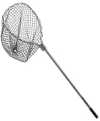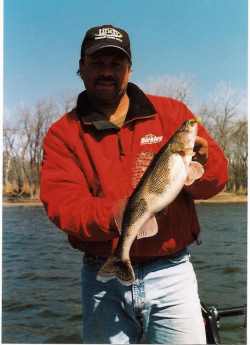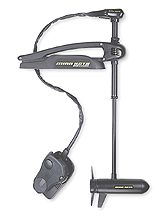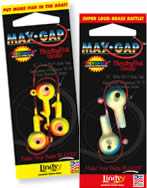

Beckman Nets Now on Sale
Click
here to order

Knife and Tool Gift Set Special
Click
here for more information
 












Promotional
Team Favorites
Lodging food and more









A
Walleyes Inc. affiliate
|
Dirty Little Secrets
By JOHN KOLINSKI
April showers aren't just about May flowers. They are also nature's
version
of spring cleaning as the grit of a long winter gets washed away.For
anglers, much of that sand, dirt and topsoil ends up in the river systems
where we like to kick off the open-water season. High, dirty springtime
conditions are common on major flowages throughout walleye country. It's
not a pretty sight, but it's a fact of life on the moving water.
Fish still eat, including walleyes that are building strength for the spawn
or recovering from the rigors of procreation.
Many anglers find it difficult to locate and catch these fish. Often,
they are fishing too deep.
Shallow, dirty water is a hungry walleye's best friend. It absorbs
heat better than clear water, and that attracts baitfish. It conceals the
predator from prey that doesn't see as well in dark conditions. And when
brush or other structure is present that diverts the current and creates
pockets of slack water, it provides opportunities for walleyes to feed
efficiently.
These are dirty little secrets we can use to our advantage.Extreme
fluctuations in water levels, especially a rapid drop of several feet,
can send walleyes scurrying for the safety of the depths, but when conditions
are fairly stable or the water is on the rise, think shallow. In most Midwestern
rivers, the walleye spawn takes place in early to mid-April, depending
on the length of the days in relation to water temperatures.
 |
Bigger fish will be located in the vicinity of spawning habitat. They
tend to favor low-light periods for feeding and will cruise the shallow
sand flats or slip up onto wingdams to fill their bellies just before sunrise
and again at sunset. They typically slide into deeper water and are less
active during the day, although when water clarity is especially poor,
like 1-2 inches, and the river running fast, a current break in 6 to 8
feet of water may qualify as "the depths." If the river is really raging,
I've found them tucked in behind flooded trees and stumps or anything else
that provides a respite from the current.
Postspawn fish favor will seek out the same areas of slack water. |
Males often hang around the spawning area for awhile, but the females seem
to head downstream shortly after dropping their eggs.
Some of the best fishing of the year occurs as they disperse downstream
and
tuck in behind brush, logjams, deadfalls or rocks along the shorelines.
Often,
a foot or two of dirty water is all they need.Every few years, a system
experiences a severe flood where the river's waters reach well beyond its
banks into adjacent crop fields or backyards. The result is a buffet for
fish as the earth releases a variety of crawlers, worms, grubs and other
insect life into the water.
It's another opportunity for anglers, although I don't like to get
up into those areas because of all the debris that tends to be present.
I've had better success looking for current breaks immediately downstream
where walleyes wait for that food to reach them.
In each of these situations, a handful of basic presentations will
produce fish and most involve jigs. Crankbaits aren't usually the best
presentation because of fish location and debris in the water. Blade baits
can be effective in vertical situations, but offer limited options in terms
of scent and live bait and tend to snag up far
more than jigs in the wood and rocks.The first key to jig-fishing is
to slow down. Visibility is limited, as is a walleye's opportunity to identify
and locate its prey. The longer you can keep a bait in its face, the better
chance it will eat.
When I'm trying to locate fish along main channel current breaks,

Minnkota 101 |
I use my MinnKota bow-mount trolling motor or my Mercury four-strike
kicker to jig vertically while slipping as slowly downstream as possible.
If I'm searching flooded timber and stumps, I sometimes tie my Triton 215X
off to a tree and pitch jigs
to likely spots.Experiment with rattles, colors and scents. Anything
we can do to enhance a walleye's ability to locate our bait is a plus.
Berkley's new line of Gulp! scented baits are reported to release over
400 times more scent than plastic baits, and they last infinitely longer
than applied liquid scents.
In general, chartreuse, lime and white are visible colors, but don't
be afraid to try orange, blue and black, as well, if there is any water
clarity at all. |


Lindy
Max Gap Jigs
Click
here for more
informaiton |
Sometimes, color is less important than water displacement. While I
like a Lindy Fuzz-E-Grub or Lindy
Max Gap Jig jig tipped with a large fathead
in most vertical jigging situations, more bulk can be the way to go
when looking for fish in water shallower than four feet. The current will
dictate how small a jig you can use, but you can make a quarter-ounce hair
jig fish like an eighth-ouncer by dressing it with a big piece
of plastic such as a 4-inch grub tail, a ringworm or even a lizard.
The larger profile not only slows the jig's fall, but it makes a better
target for fish that are looking for an easy meal.A couple of other things
to consider are rod sensitivity and line choice.When a bait is moving,
a rod with a quick tip like a Berkley Series One is
critical. The 6-foot model is ideal for vertical situations and the
6 1/2-footer is perfect for pitching to shallow water and following a jig
downstream. |
High visibility, abrasion-resistant line is another advantage when current
restricts the sensitivity between an angler and his or her jig and
snaggy
habitat is part of the plan. Berkley's IronSilk is tough and the Solar
Mint color
will help you see the strikes you can't always feel. This spring, don't
let high, muddy water keep you at home or limit your catch. Those walleyes
are eating. Think shallow, and you'll get your share of them. It's a dirty
little secret that can turn difficult conditions into productive springtime
outings.
E-mail
John Kolinski
Editor's note: John Kolinski is the 2002
Professional Walleye Trail Angler of the Year and a 13-time championship
qualifier on the PWT, RCL and Masters Walleye Circuit. His articles can
be read in numerous Midwestern outdoor publications and several web sites.
Kolinski is sponsored by Triton Boats, Mercury Motors, Lowrance Electronics,
Normark/Storm Lures, MinnKota, Lindy Legendary Tackle, Flambeau, Tempress
Rod Holders, Off-Shore Planer Boards, Berkley Trilene, Optima Batteries
and Panther Marine.

Fish
Clix Banner Exchange
Walleyes Inc. website is maintained
by Randy
Tyler Fishing the In-Fisherman Professional Walleye Circuit, Masters
Walleye Circuit and the Wal Mart RCL Circuit. All rights reserved.Copyright
1999/2004
Please visit these site sponsors
Daiichi/Tru-Turn Hooks,
Lindy
Little Joe,
R-A.M Mounting Systems,
Ranger
boats, Mercury Outboards,Bedford
Sales , Church Tackle, Panther
Marine Products,
Webfoots body sock,
Bait
Rigs Tackle ,Dual Pro Charging Systems,
Daiwa
Rods and Reels,
Driftcontrol
Wind socks,
Trojan Batteries
|






